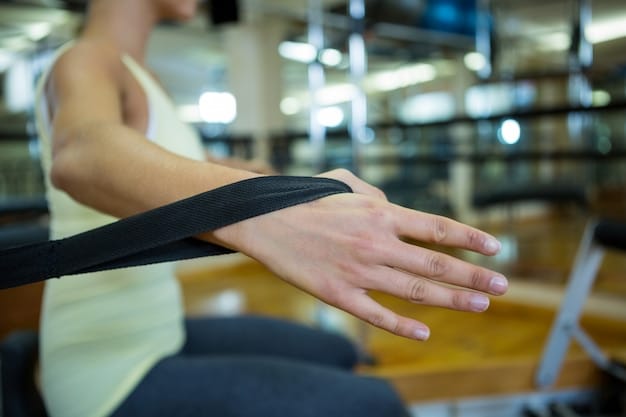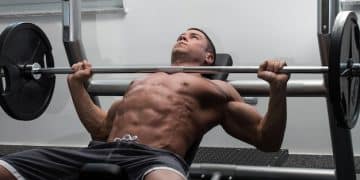Master Your Grip: Forearm Workout for Peak Performance

A robust forearm workout routine is crucial for enhancing grip strength, which underpins performance in countless sports, daily activities, and resistance training, directly contributing to injury prevention and overall functional fitness.
In the quest for peak physical performance, many fitness enthusiasts meticulously craft routines for major muscle groups, often overlooking an unsung hero: the forearms. Yet, to Build a Stronger Grip: The Forearm Workout Routine for Performance is not merely about aesthetics; it’s a foundational element influencing everything from lifting heavier weights to dominating in sports.
The Unsung Importance of Forearm Strength
Forearms, though often secondary in workout discussions, are critical to almost every upper-body movement. Their strength directly translates to your ability to lift, pull, carry, and even maintain proper form during complex exercises. Understanding their multifaceted role is the first step towards prioritizing their development.
From gripping a barbell during a deadlift to swinging a tennis racket with precision, the muscles of the forearm act as the primary movers and stabilizers. Neglecting them can create a weak link in your kinetic chain, limiting your potential across the board. Strong forearms also play a significant role in injury prevention, particularly in the wrists and elbows, by providing stability and resilience under stress.
Functional Benefits Beyond the Gym
The impact of a strong grip extends far beyond the gym walls. Everyday tasks, often taken for granted, become significantly easier and safer with well-developed forearms. Imagine effortlessly carrying groceries, opening stubborn jars, or performing household chores without strain.
- Enhanced Daily Living: Simple tasks like carrying heavy bags or opening tightly sealed containers become less strenuous and more manageable.
- Injury Prevention: A robust forearm and grip can help stabilize the wrist and elbow joints, reducing the risk of conditions like tennis elbow or carpal tunnel syndrome, especially for those engaging in repetitive gripping activities.
- Improved Endurance: Strong forearms mean your grip won’t give out before your larger muscle groups during prolonged activities, enhancing overall stamina in sports and workouts.
Furthermore, professions requiring fine motor skills or sustained gripping, such as carpentry, rock climbing, or even surgery, benefit immensely from specific forearm training. It’s about building practical, transferable strength that services all aspects of your life.
Performance in Sports and Athletics
In the athletic arena, grip strength is not just an advantage; it’s often a prerequisite for high performance. Consider sports like gymnastics, where holding onto rings or bars requires immense forearm endurance. In combat sports, a strong grip can mean the difference between maintaining control and losing it.
Think about baseball, where the ability to control the bat or throw a fastball with force depends heavily on forearm and hand strength. In football, a powerful grip is essential for catching the ball securely and tackling opponents effectively. Even in swimming, a strong “pull” through the water relies on the intricate strength of the forearms and hands.
From team sports to individual disciplines, the transferability of forearm strength is undeniable. It enhances control, precision, and power, providing a competitive edge that can often determine the outcome.
Anatomy of the Forearm: Understanding Your Muscles
To effectively train your forearms, a basic understanding of their anatomy is essential. The forearm is a complex region containing over a dozen muscles, broadly categorized into two groups: flexors and extensors. These muscles perform distinct actions and require targeted exercises for comprehensive development.
The flexor muscles, located on the underside of your forearm (the palm side), are primarily responsible for flexing the wrist and fingers, allowing you to grip and curl. Conversely, the extensor muscles, found on the top of your forearm (the back of the hand side), extend the wrist and fingers, enabling movements like opening your hand or typing.
Forearm Flexors: The Gripping Powerhouses
The flexor group is often what people associate most with “grip strength.” These muscles are crucial for any pulling motion, whether it’s lifting weights, executing a chin-up, or even carrying heavy bags. Targeting them effectively is key to building crushing grip power.
- Flexor Carpi Radialis & Ulnaris: These muscles work together to flex the wrist and move it towards the thumb or pinky finger, respectively.
- Palmaris Longus: A thin muscle that assists in wrist flexion.
- Flexor Digitorum Superficialis & Profundus: These powerful muscles are responsible for flexing the fingers, allowing you to make a fist and grip objects.
- Brachioradialis: While primarily a flexor of the elbow, it’s a prominent and visible forearm muscle that contributes significantly to overall forearm bulk and strength, especially during hammer curls.
Training these muscles involves movements that mimic gripping, curling, and wrist flexion. Developing them not only enhances your lifting capacity but also contributes to the aesthetic fullness of your forearms.
Forearm Extensors: Stability and Counterbalance
Often overlooked, the extensor muscles are just as vital as the flexors. They provide balance, preventing imbalances that can lead to injury, and are crucial for movements requiring wrist extension and finger spreading. A common mistake is to overemphasize flexor training while neglecting extensors.
The extensor muscles run along the back of the forearm, allowing you to extend your wrist and fingers. While they may not contribute as directly to “grip” in the traditional sense, their strength is critical for antagonist balance and overall wrist health. Without strong extensors, the dominant flexors can pull the wrist into an unbalanced position, leading to discomfort or injury.
Exercises for extensors typically involve wrist extension against resistance, movements that open the hand, and reverse gripping actions. Incorporating these ensures a well-rounded and resilient forearm.
Crafting Your Forearm Workout Routine
Designing an effective forearm workout routine involves selecting the right exercises, determining appropriate sets and repetitions, and integrating proper progression. The goal is to stimulate both the flexor and extensor muscles, ensuring comprehensive development and functional strength.
Variety is key in forearm training. The muscles of the forearm respond well to different rep ranges and types of resistance. Incorporating static holds, dynamic movements, and eccentric contractions can maximize muscle growth and strength gains. Consistency, as with any muscle group, is paramount.
Essential Exercises for Grip Strength
For targeting the flexors and building a powerful grip, several exercises stand out. These movements focus on curling with the wrist and maintaining a strong hold, directly engaging the muscles responsible for crushing strength.
- Barbell Wrist Curls: Sit on a bench, forearms resting on your thighs, palms up, holding a barbell. Lower the barbell by extending your wrists, then curl it back up towards your forearms. This exercise specifically targets the forearm flexors.
- Dumbbell Wrist Curls (Supinated): Similar to barbell curls, but using dumbbells allows for a greater range of motion and individual arm isolation. Hold dumbbells with palms up, forearms on thighs, and curl the dumbbells up.
- Plate Pinches: Hold two or more weight plates together with your thumb on one side and fingers on the other, maintaining the grip for as long as possible. This builds crushing strength and finger dexterity.
- Farmer’s Walks: This full-body exercise is exceptional for grip endurance. Hold heavy dumbbells or kettlebells in each hand and walk for a set distance or time. The sustained grip challenge taxes the forearms intensely.
When performing these exercises, focus on a controlled movement both concentrically (lifting) and eccentrically (lowering). Avoid using excessive weight that compromises form; the mind-muscle connection is vital for forearm development.
Targeting Forearm Extensors and Dexterity
Balancing your forearm training means giving equal attention to the extensors. These exercises counteract the constant flexion of daily life and gripping exercises, promoting overall forearm health and preventing imbalances.
- Barbell Reverse Wrist Curls: Sit on a bench with forearms resting on your thighs, palms down, holding a barbell. Lower the barbell by flexing your wrists, then extend them upwards, curling the barbell back towards your forearms.
- Dumbbell Reverse Wrist Curls (Pronated): Similar to barbell reverse curls but with dumbbells, allowing for unilateral work. Hold dumbbells with palms down, forearms on thighs, and extend the wrists upwards.
- Rice Bucket Training: Submerge your hands into a bucket of rice and perform various movements like opening and closing your fist, twisting, and scooping. This provides unique resistance for both flexors and extensors, as well as improving joint mobility.
These exercises might feel less intuitive than their flexor counterparts, but their importance cannot be overstated. They contribute to wrist stability and overall forearm resilience, crucial for preventing injuries and enhancing grip longevity.

Incorporating Static Holds and Endurance Training
Beyond dynamic movements, static holds and endurance exercises are paramount for building lasting grip strength and forearm stamina. These methods challenge your muscles to sustain tension over time, mimicking real-world functional demands.
Static holds involve maintaining a position against resistance for an extended period, taxing the muscles under constant tension. This is particularly effective for improving the sheer power and endurance of your grip, which is essential in tasks where you need to hold onto something for a prolonged duration.
- Dead Hangs: Simply hang from a pull-up bar with an overhand grip for as long as you can. This is an excellent way to build passive grip strength and improve shoulder health. For added challenge, use a thicker bar or wrap a towel around the bar.
- Plate Holds: Hold a weight plate (with your fingers and thumb, as in plate pinches) for a specific duration or until failure. This targets the crushing grip intensely.
- Fat Grip Training: Using specialized fat grips on barbells and dumbbells increases the diameter of the bar, making your grip work harder. This automatically enhances forearm activation during any exercise, from bicep curls to rows.
Endurance training ensures your grip doesn’t fatigue prematurely during longer workouts or athletic events. Incorporating longer sets with lighter weights or extending the duration of static holds can significantly boost your forearm stamina.
Workout Frequency, Sets, and Reps
The optimal frequency, sets, and repetitions for forearm training can vary depending on your overall training volume and recovery capacity. However, because forearms are involved in so many exercises, they often recover faster and can be trained more frequently than larger muscle groups.
For most individuals, training forearms 2-3 times per week, either at the end of a regular workout or on a dedicated day, proves effective. If you’re new to direct forearm training, start with 1-2 sessions per week to allow your muscles to adapt.
Progressive Overload and Deloading
Like any other muscle group, forearms respond to progressive overload. This means gradually increasing the demands placed on your muscles over time. This could involve increasing the weight, reps, sets, or decreasing rest times. While the forearm muscles are resilient, they are not immune to overtraining.
Varying your rep ranges can be highly beneficial. For strength development, aim for lower reps (e.g., 5-8) with heavier weights. For muscle hypertrophy (growth), stick to moderate reps (e.g., 8-15). For endurance, higher reps (15-20+) or longer static holds are ideal. Periodically, incorporate deload weeks where you reduce the volume or intensity to allow for complete recovery and prevent plateaus.
The concept of “time under tension” is particularly relevant for forearm training. By slowing down the eccentric (lowering) phase of movements, you can increase the muscular engagement and stimulate growth more effectively, even with lighter weights.
Integrating Forearm Training into Your Routine
Forearm exercises can be incorporated into your existing workout routine in several ways. One common approach is to add them at the end of an upper-body day, particularly after back or biceps training, as these exercises already heavily engage the forearms indirectly.
Alternatively, you can sprinkle forearm exercises throughout your week. For example, doing dead hangs on one day, followed by wrist curls on another, and plate pinches on a third. This distributed approach can sometimes lead to better recovery and more consistent stimulus.
Another effective strategy is to dedicate a small amount of time to forearm work multiple times a week. Even 10-15 minutes of focused training, three to four times a week, can yield significant results over time. The key is consistency and adaptation.
Nutrition and Recovery for Forearm Growth
While specific exercises are the foundation of forearm development, nutrition and recovery are the unsung pillars that support muscle growth and strength gains. Adequate fuel and rest ensure your forearms can repair and grow stronger after intense training sessions.
Muscle growth, or hypertrophy, requires a surplus of calories and sufficient protein intake. Protein provides the amino acids necessary for muscle repair and synthesis, while carbohydrates replenish glycogen stores, providing energy for workouts and aiding recovery.
Fueling Your Forearms: Macronutrients and Hydration
Your diet needs to support your training goals. For muscle growth, a general guideline is to consume 1.6-2.2 grams of protein per kilogram of body weight daily. This should be spread throughout the day, including before and after workouts.
- Protein: Aim for lean sources such as chicken breast, fish, eggs, lean beef, and dairy. Plant-based options include lentils, beans, tofu, and quinoa.
- Carbohydrates: Complex carbohydrates like oats, brown rice, whole-wheat bread, and sweet potatoes provide sustained energy for your workouts and help rehydrate muscles.
- Healthy Fats: Sources like avocados, nuts, seeds, and olive oil are crucial for hormone production and overall cellular health, supporting recovery.
- Hydration: Water is essential for every bodily function, including nutrient transport and muscle contractions. Ensure you are well-hydrated throughout the day, especially during and after exercise.
Micronutrients, found in a diverse range of fruits and vegetables, also play a vital role. They provide vitamins and minerals necessary for energy production, immune function, and overall well-being, all of which indirectly contribute to your recovery and performance.

The Importance of Rest and Sleep
Muscle growth doesn’t happen in the gym; it happens during recovery. Sleep is arguably the most critical component of recovery, as it’s when your body produces growth hormone and repairs damaged muscle tissues. Aim for 7-9 hours of quality sleep per night.
Overtraining your forearms can lead to diminishing returns, injury, and burnout. If your forearms feel constantly sore, weak, or you notice a decline in performance, it’s a sign that you might need more rest. Incorporate active recovery days, like light cardio or stretching, to promote blood flow and aid muscle repair without adding significant stress.
Listening to your body is crucial. If you’ve had a particularly intense lifting session that heavily engaged your grip (e.g., heavy deadlifts, pull-ups), consider giving your forearms an extra day of rest before a dedicated forearm workout. Prioritizing recovery ensures sustainable progress and prevents plateaus.
Common Mistakes to Avoid in Forearm Training
While forearm training seems straightforward, several common pitfalls can hinder progress or even lead to injury. Being aware of these mistakes can help you optimize your routine and ensure safe, effective training.
Many individuals make the mistake of either neglecting forearm training entirely or overdoing it without proper recovery. Achieving the right balance is key to maximizing gains while minimizing risk.
Neglecting Extensors
As discussed, focusing solely on flexor exercises (like wrist curls) while ignoring extensors is a common mistake. This creates muscular imbalances that can lead to wrist pain, tendinitis, and compromised performance. Always include exercises that target both groups for balanced development.
The extensor muscles, though seemingly less “glamorous,” are crucial for antagonist balance. Without them, the stronger flexors can pull the wrist into an unhealthy position, setting the stage for overuse injuries. Think of it as balancing a door: you need hinges on both sides to swing properly without straining one side.
Over-reliance on Wrist Straps
While wrist straps can be beneficial for specific heavy lifts (like deadlifts or rows) when your grip is the limiting factor for larger muscle groups, over-reliance on them can hinder forearm development. If you consistently use straps, your forearms never get the chance to adapt and grow stronger.
Use straps judiciously. Save them for your heaviest sets when your target muscles can handle more weight than your grip can. For lighter sets and warm-ups, forgo the straps to challenge your grip naturally. This allows your forearms to gain strength organically over time.
Ignoring Progressive Overload
Some individuals treat forearm exercises lightly, performing the same routine with the same weight for extended periods. Forearms, like any other muscle, require progressive overload to grow. Continuously challenge them by increasing weight, reps, sets, or manipulating tempo and rest periods.
It’s important to track your progress. Keep a log of your forearm workouts, noting the weight, sets, and reps. This allows you to monitor your improvement and ensures you’re consistently pushing yourself beyond your current capabilities, leading to continuous adaptation and strength gains.
Advanced Techniques and Equipment
Once you’ve built a solid foundation with basic forearm exercises, you might consider incorporating advanced techniques and specialized equipment to further challenge your grip and stimulate growth.
These methods are designed to increase the intensity, create unique forms of resistance, or specifically target areas that might be lagging. They are excellent for breaking through plateaus and adding variety to your routine.
Specialized Grip Tools
The market offers a range of tools specifically designed to enhance grip strength, targeting various aspects of forearm musculature.
- Hand Grippers: These devices, ranging from light resistance to extremely heavy, allow you to train your crushing grip. They come in various spring tensions, enabling progressive overload.
- Leverage Bars (Wrist Rollers): These tools isolate the wrist flexors and extensors by allowing you to roll a weight up and down using only your wrists. They are excellent for building forearm size and definition.
- Thick Bar Training: As mentioned, using fat grips or specialized thick bars instantly makes any exercise more challenging for your forearms. This is arguably one of the most effective ways to build a strong, functional grip.
- Gripping Chains and Vices: Advanced equipment that provides highly specific and intense resistance, often used by strongmen and powerlifters to develop immense grip strength.
When using specialized tools, remember to integrate them thoughtfully into your routine. They are supplements to, not replacements for, foundational exercises. Start with lighter resistances and gradually increase as your strength improves.
Bodyweight and Odd Object Training
Beyond traditional weights and specialized tools, bodyweight exercises and odd object training offer unique ways to challenge your forearms and grip strength, often mimicking real-world functional movements.
Exercises like rope climbing, particularly without using your legs, are incredible for developing full-body strength and immense forearm endurance. Other bodyweight movements, such as various forms of hanging or gymnastic holds, place significant demands on the hands and forearms.
Odd object training, like carrying heavy stones, sandbags, or awkward implements, challenges your grip in dimensions that traditional dumbbells cannot. The unstable nature of these objects forces your forearms to work harder to maintain control, building both strength and stability.
Incorporating these less conventional methods can add an exciting and effective dimension to your forearm training, fostering raw, transferable strength that goes beyond the typical gym environment.
| Key Point | Brief Description |
|---|---|
| 💪 Forearm Pillars | Target both flexors (grip) and extensors (stability) for balanced strength & injury prevention. |
| 🏋️♂️ Diverse Exercises | Incorporate wrist curls (barbell/dumbbell), reverse curls, plate pinches, and farmers walks. |
| 📈 Progressive Overload | Gradually increase weight, reps, sets, or time under tension to ensure continuous growth. |
| 🍎 Recovery & Fuel | Prioritize adequate protein intake, hydration, and 7-9 hours of sleep for optimal muscle repair. |
Frequently Asked Questions About Forearm Training
▼
For most individuals, training forearms 2-3 times per week is ideal. Because forearms are small muscles often involved in other lifting, they recover relatively quickly. Start with 1-2 sessions if you’re new to direct forearm training to allow for proper adaptation and avoid overtraining or injury.
▼
While heavy lifts like deadlifts certainly engage your forearms significantly, relying solely on them may not be enough for optimal forearm development. These exercises primarily work the gripping flexors statically. Direct forearm training, including both dynamic exercises and extensor work, is crucial for comprehensive strength and balance.
▼
Increasing grip endurance involves exercises that challenge your forearms to sustain tension over time. Farmer’s walks are exceptionally effective. Dead hangs from a pull-up bar, plate holds for time, and using fat grips on barbells or dumbbells during your regular exercises will also significantly boost your grip endurance and stamina.
▼
Yes, forearm extensors are just as important as flexors. Neglecting them can lead to muscular imbalances, which may cause wrist pain, tendinitis, or hinder overall performance. Training both flexors and extensors ensures balanced development, improves wrist stability, and significantly reduces the risk of common overuse injuries in the wrist and elbow.
▼
Yes, strengthening your forearms, focusing on both flexors and extensors, can often alleviate and prevent wrist pain. Strong forearm muscles provide better support and stability to the wrist joint. However, if you experience persistent or severe pain, it’s crucial to consult a healthcare professional, as underlying conditions may require specific medical attention.
Conclusion
Developing a robust grip and strong forearms is not an accessory to your fitness journey but a fundamental component of it. From boosting your performance in the gym and on the field to enhancing your capabilities in daily life, the benefits are expansive and tangible. By understanding forearm anatomy, integrating a balanced routine of flexor and extensor exercises, prioritizing progressive overload, and committing to proper nutrition and recovery, you can unlock a new level of physical prowess. Embrace the often-overlooked training of your forearms, and you’ll soon discover an undeniable strength that permeates every aspect of your physical endeavors, solidifying your foundation for peak performance and resilience.





